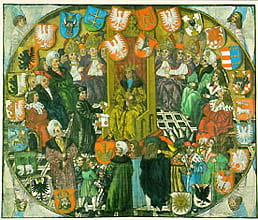Essay by Maja Trochimczyk
Bogurodzica (The Mother of God) is the oldest song with Polish words. This hymn, with its title providing an exact translations of the Greek expression “Theotokos”, originated most probably in the 13th century, while its earliest extant sources date back to the 15th century. Unfortunately, the names of the author and composer of the prayer are unknown. As one of the earliest written documents of the Polish language, Bogurodzica has a firm place in Polish cultural history – it has been discussed as an instance of the most archaic form of the Polish language, the first preserved document of Polish poetry, and an example of medieval, religious “high art” music. Bogurodzica is a religious hymn, a simple prayer for personal happiness on earth and for a blessed life in heaven. Despite its religious focus, this chant, through the centuries of its existence, became a symbol of issues often only loosely associated with its spiritual meaning.
It is assumed that Bogurodzica was widely known in the 14th century since the Polish knights sang it as an anthem before the Battle of Grunwald (July 15, 1410) and during the battle with the Turkish army at Varna in 1444 (when the European armies were defeated and the young Polish king Vladislaus IV died). The same song accompanied the coronation ceremonies of the first Jagiellonian kings and was printed in Jan Łaski’s “Statures of the Polish Kingdom.” Its importance considerably diminished in the 16th century.
In more recent times, Bogurodzica has usually been printed in patriotic – religious hymnals and popular church songbooks as the first, most ancient and revered song. It is still being sung in Polish churches, especially in the monastic orders, but the language is too obscure and the music too difficult for the hymn’s widespread use in congregational singing. Bogurodzica’s shift to the role of a historical monument may be credited both to the archaic the language and to the complexity of the music – with a monophonic, modal melody that is not easily harmonized and adjusted to the major/minor tonal system. Nonetheless, throughout its history the chant has served two main roles : it has been used as a sign of national identity (as the earliest example of written Polish language and as the traditional national anthem) and as a sign of devotion to the Mother Mary, a symbol of Poland’s all – pervading Catholicism.
Sources of Material
The text is based on Maja Trochimczyk’s essay “Sacred versus Secular: The Convoluted History of Polish Anthems,” in After Chopin: Essays in Polish Music, ed. Maja Trochimczyk, vol. 6 of Polish Music History Series (Los Angeles: Friends of Polish Music at USC, 2000).
The recording of the male choir is from Boze, cos Polske CD, performed by the Rorantists, conducted by Stanislaw Gałoński. The CD is by State Folk Dance Group Mazowsze, issued by Polskie Nagrania, ECD 034.
The recording of the female choir is from the CD of Schola Cantorum Bialostociensis, cond. Violetta Bilecka (Bialystok: Spoleczny Zarzad Choru, n.d., SZC 001).
The 1928 edition of Bogurodzica is from Jan Siedlecki, ed. Spiewnik koscielny z melodjami na dwa glosy [Church Songbook with Melodies, for two Voices] (Lwow-Krakow-Paris: Missionary Fathers, 1928).
The 19th-century postcards of symbolic imagery and Polish emblems are from Maja Trochimczyk Collection.
